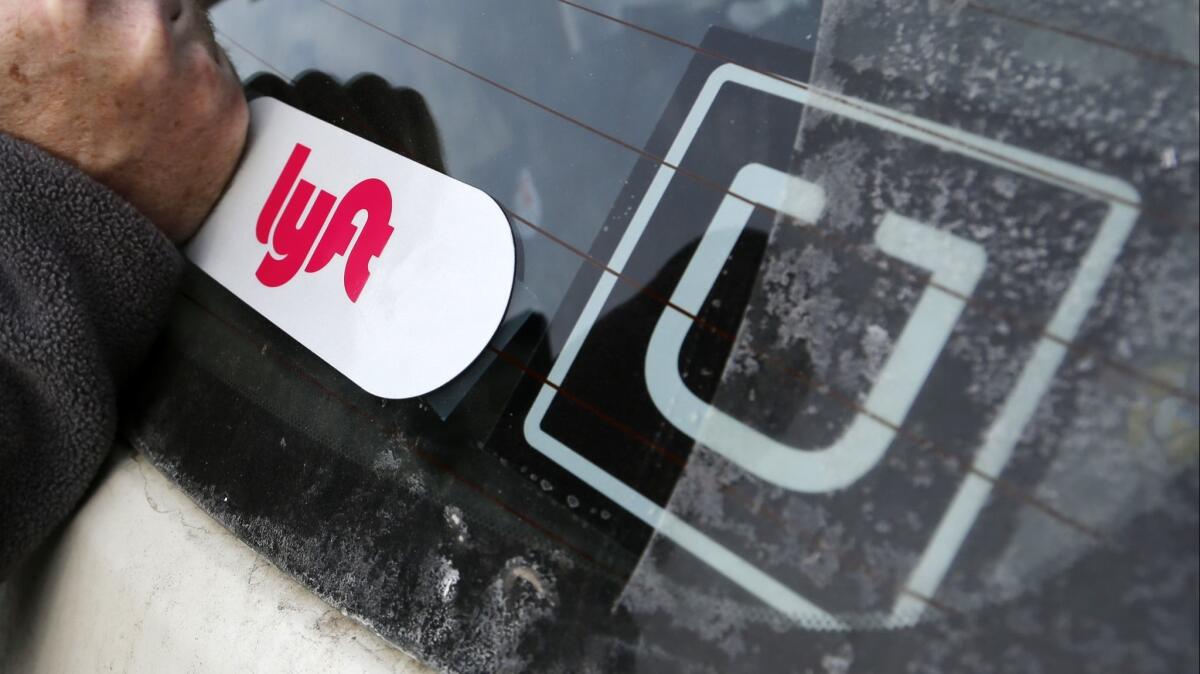Most Uber and Lyft drivers in L.A. work full time and still struggle to make ends meet, study says

- Share via
Reporting from San Francisco — When ride-hailing services Uber and Lyft arrived in Los Angeles six years ago, they sold Angelenos on the narrative that driving for their companies was little more than a side-hustle — a flexible way to make money while being your own boss.
That narrative is no longer true in 2018, according to research released Wednesday from UCLA’s Institute for Research on Labor and Employment, which found that more than half of Uber and Lyft drivers in Los Angeles drive full time. Many also struggle to pay for expenses such as gas, insurance and vehicle maintenance costs, and around a third either purchased or leased their car specifically to drive for the companies and must now continue driving to pay off those loans.
“We knew from seeing the news coverage that conditions for Uber and Lyft drivers were bad, but it was shocking to see how bad it was,” said Lucero Herrera, a coauthor of the report.
Around half of Uber and Lyft drivers surveyed said it’s their only job, and roughly the same percentage said they work more than 35 hours a week and struggle to pay for gas, insurance and car maintenance costs. Many said they drive extra hours, borrow money, or use a credit card to pay those expenses.
About two-thirds of respondents said driving for Uber or Lyft was their main source of income.
The majority of respondents said they wanted higher wages and payment transparency, the ability to choose their passengers without penalty, and assistance with vehicle care and maintenance. The drivers — who are classified as independent contractors rather than employees — overwhelmingly said they want to negotiate the conditions of their contract with Uber and Lyft.
Uber and Lyft, which were not consulted for the report, pushed back on the findings, noting that its 260 survey participants represent only a small fraction of the tens of thousands of ride-hailing drivers in Los Angeles County.
An Uber spokesperson also drew attention to the report’s research advisors, one of which is a member of the National Taxi Workers Alliance — a group that has historically been critical of the ride-hailing industry.
Citing Lyft’s own research, which was released this year, the company’s Los Angeles general manager, Allen Narcisse, said that Lyft surveyed 37,000 of its own drivers across the country and found that the majority use it to supplement their income.
“In Los Angeles specifically, 93% drive fewer than 20 hours per week,” Narcisse said.
Driver earnings and work conditions have long been a point of contention for ride-hailing companies, with a growing chorus of drivers expressing dissatisfaction with declining pay and a lack of control over their fares. Uber and Lyft have remained steadfast in their stance that they give drivers flexibility and neither have budged on the matter of fares, although both have recently made concessions to sweeten the deal for drivers, offering discounts on gas, maintenance and insurance, rewarding drivers with cash bonuses and embarking on listening tours to make drivers feel heard.
Still, some researchers worry that Uber’s and Lyft’s business models are leading to a decline in labor standards, while others posit that the gig economy is itself an alternative safety net that allows those who are otherwise out of a job to keep their heads above water.
Herrera said she hopes the report will at the very least raise awareness among drivers, regulators and members of the public so they can start talking about ways to protect drivers and improve working conditions.
“We want to lift the voice of the drivers and spur a conversation so we can work together to improve this industry,” Herrera said.
Twitter: @traceylien







